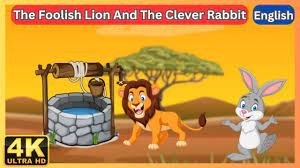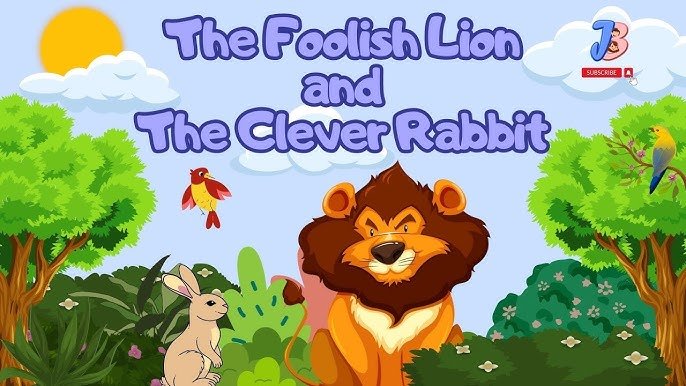Beneath the deceptively simple story of a small rabbit outmaneuvering the king of beasts lies one of humanity’s most enduring narratives about intellectual rebellion against brute force. While most familiar through the Indian Panchatantra (circa 300 BCE), this “weak defeats strong through wit” archetype appears globally—from African folklore’s hare tricking lions to Chinese variants where a rabbit fools a tiger, and even Cherokee tales of a coney confounding a bear. The classic Indian version unfolds with a despotic lion terrorizing the animal kingdom, demanding daily sacrifices until a clever rabbit volunteers, deliberately arriving late to provoke the lion’s rage.
Exploiting the predator’s arrogance, the rabbit claims another lion is challenging his rule and leads him to a well, where the lion attacks his own reflection and drowns. This narrative masterpiece operates on multiple levels: as political allegory (the rabbit representing diplomatic resistance), psychological study (the lion’s ego as fatal flaw), and even early science (using water’s reflective properties tactically).
What most versions omit is the story’s deeper Panchatantra context—it was originally framed as a lesson for princes about governing through wisdom rather than fear. The lion (Pingalaka in Sanskrit texts) embodies tyrannical rulers who eventually fall to their own hubris, while the rabbit (Saraká) represents the ideal advisor—small in stature but vast in strategic thinking. The well holds symbolic significance in Indian philosophy as both truth-mirror and karmic justice.
Jain adaptations add fascinating layers—the rabbit is reborn as a future king, suggesting cleverness leads to enlightenment. Modern behavioral scientists recognize the rabbit’s tactics as textbook “asymmetric conflict strategy”—when direct confrontation is impossible, redirect the opponent’s strength against itself. The lion’s fatal error—failing to question the rabbit’s claim—illustrates what psychologists now call “cognitive entrenchment,” where power blinds critical thinking.

The characters represent masterful archetypes. The lion isn’t merely strong but psychologically complex—his initial reasonable demand for one daily animal shows calculated control, while his later unthinking rage reveals the fragility of bullies. The rabbit’s brilliance lies not just in quick thinking but in emotional intelligence—he observes the lion’s pride is his Achilles’ heel. Even the silent well serves as a character—an impartial force of nature that enables justice without violence. The story’s structure follows classical Indian katha storytelling, with five strategic elements: 1) establishing oppressive power, 2) introducing the underdog, 3) crafting the trap, 4) exploiting the enemy’s nature, and 5) delivering poetic justice—a template later used in everything from Shakespearean dramas to modern heist films.
Historically, this fable traveled further than perhaps any other. Persian scholar Ibn al-Muqaffa adapted it into Kalila wa Dimna for caliphs, emphasizing court intrigue. European versions during the Renaissance transformed the rabbit into a fox (better known locally) and the well into a pit—adaptations that preserved the core lesson while localizing symbols. The story’s influence appears in unexpected places: Sun Tzu’s Art of War references a similar stratagem (making enemies overestimate threats), while Machiavelli praised its tactical brilliance. Modern economists see parallels in David-vs-Goliath market competition, where startups use incumbent giants’ size against them.
Scientific research validates the fable’s insights. Studies on predator-prey dynamics show smaller animals often survive through deception—like rabbits thumping to mimic larger creatures. Neuroscientists find that power literally impairs perspective-taking—explaining the lion’s failure to doubt the rabbit. The “well scene” mirrors modern conflict resolution techniques—redirecting aggression into harmless outlets. Even children’s cognitive development reflects the moral—kids who solve problems creatively (like the rabbit) outperform physically stronger peers long-term.
Today, the fable’s applications are endless. Entrepreneurs use it to teach disruptive innovation, activists reference it for nonviolent resistance strategies, and psychologists employ it in anger management therapy (the lion’s rage as self-destruction). Its most profound modern interpretation may be in AI development—the rabbit’s approach exemplifies how artificial intelligence could solve problems by leveraging opponents’ weaknesses rather than matching strength.
Ultimately, The Clever Rabbit and the Lion endures because it celebrates intelligence as the ultimate equalizer. In classrooms teaching critical thinking, boardrooms discussing competition, or even international relations analyzing asymmetric warfare, this ancient tale remains startlingly relevant. It doesn’t just entertain—it encodes a survival blueprint for the powerless against the powerful, proving that the pen (or paw) that outthinks is mightier than the claw that overpowers. From ancient Indian courts to Silicon Valley startups, its message resonates: true power lies not in teeth, but in thought.
Go to main page


